Un plugin específico para un sitio te permite añadir fácilmente fragmentos de código a tu sitio web WordPress sin depender de tu tema. Te permite utilizar código personalizado para mejorar tu sitio y no preocuparte por tener que rehacerlo todo cuando se actualice tu tema.
En WPBeginner, hemos creado un montón de plugins específicos del sitio para añadir códigos cortos, nuevos tipos de post, y otras características a nuestro sitio en el pasado. Además, también hemos ayudado a nuestros clientes a empezar con plugins específicos del sitio.
En este artículo, explicaremos cómo crear un plugin de WordPress específico para un sitio y por qué es importante.
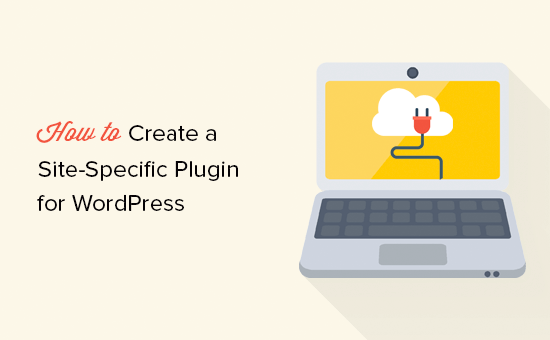
¿Qué es un plugin de WordPress específico para un sitio?
Un plugin de WordPress específico para un sitio es un plugin independiente que puede utilizar para añadir todos los fragmentos de código de personalización que no dependen del tema.
Cuando trabaje en su sitio web, a menudo encontrará tutoriales de WordPress que le pedirán que añada código al archivo functions.php de su tema o a un plugin específico del sitio.
WordPress no incluye plugins específicos para cada sitio. Tendrás que crear el tuyo propio y luego instalarlo y activarlo.
¿Por qué crear un plugin de WordPress específico para un sitio?
Como hemos mencionado antes, a menudo encontrarás tutoriales que muestran algún código que puedes añadir al archivo functions.php de tu tema o a un plugin específico del sitio.
Estos códigos personalizados se pueden utilizar para añadir nuevos tipos de entradas, taxonomías, códigos cortos, y un montón de hacks para mejorar su sitio web.
Si añades el código personalizado al archivo de funciones de tu tema, desaparecerá si actualizas o cambias de tema.
Puede crear un tema hijo y utilizar el archivo de funciones del tema hijo para guardar su código. Sin embargo, tu código desaparecerá si cambias de tema.
Un plugin de WordPress específico para cada sitio te permite añadir fácilmente fragmentos de código personalizados a tu sitio web de WordPress y asegurarte de que son independientes del tema. Es un plugin de WordPress independiente, lo que significa que no depende de su tema, y usted es libre de actualizar o cambiar su tema.
Dicho esto, echemos un vistazo a cómo añadir fácilmente código personalizado utilizando un plugin específico del sitio. Le mostraremos dos maneras de hacerlo, y usted puede elegir el método que funcione mejor para usted (pista: Método # 2 es más fácil para los principiantes).
Método 1: Crear manualmente un plugin de WordPress específico para cada sitio
Sabemos que esto puede sonar un poco friki para los principiantes, pero intentaremos simplificártelo al máximo.
En primer lugar, debes crear una nueva carpeta en tu escritorio y darle el nombre de tu sitio web. Por ejemplo: mywebsite-plugins.
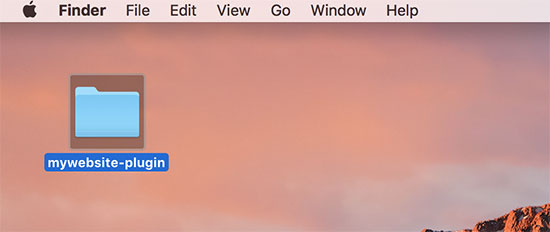
Ahora, abre un editor de texto plano en tu ordenador como Notepad o TextEdit.
Debe crear un nuevo archivo y guardarlo como mywebsite-plugin.php en la carpeta de plugins de su escritorio.
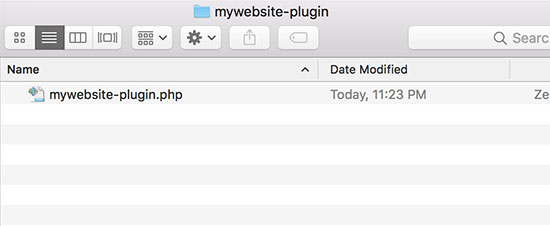
El archivo de su plugin necesita un código de cabecera específico para que WordPress pueda reconocerlo como plugin. Siga adelante y añada el siguiente código a su archivo mywebsite-plugin.php:
1 2 3 4 5 6 7 8 9 | <?php/*Plugin Name: Site Plugin for example.comDescription: Site specific code changes for example.com*//* Start Adding Functions Below this Line *//* Stop Adding Functions Below this Line */?> |
Puede sustituir example.com por su propio nombre de dominio. Una vez hecho esto, el plugin específico de su sitio estará listo.
Hay dos formas de subir un plugin específico para un sitio web. Puede subirlo a través de su panel de administrador de WordPress o utilizar FTP.
1. Instalar plugin específico del sitio desde el área de administrador de WordPress (recomendado)
Este método es más sencillo y recomendable para todos los usuarios.
En primer lugar, debe crear un archivo zip con la carpeta de plugins específica de su sitio.
Los usuarios de Windows sólo tienen que hacer clic con el botón derecho del ratón en la carpeta de plugins y seleccionar Enviar a ” carpeta comprimida (zip).
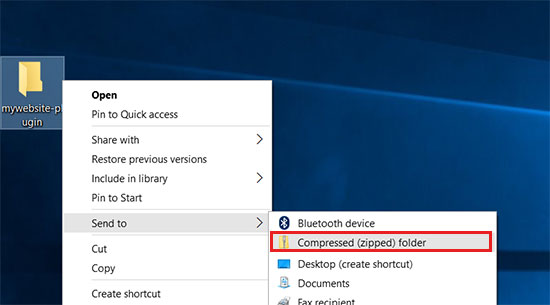
Los usuarios de Mac deben hacer clic con el botón derecho.
A continuación, seleccione “Comprimir mywebsite-plugin”.
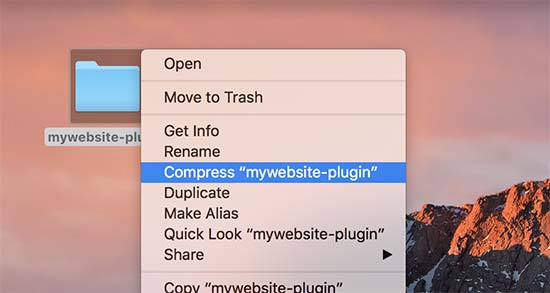
Una vez que tenga el archivo zip del plugin, vaya a la página Plugins ” Añadir nuevo en su área de administrador de WordPress.
A continuación, haga clic en el botón “Subir plugin” de la parte superior.
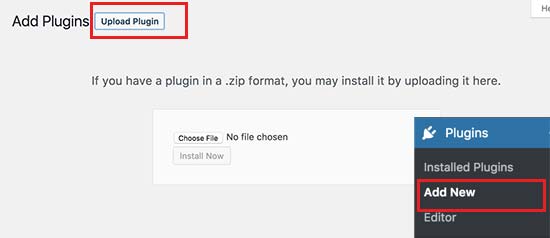
A continuación, haz clic en el botón “Elegir archivo” para seleccionar el archivo zip que has creado antes y, a continuación, haz clic en el botón “Instalar ahora”.
WordPress subirá e instalará el plugin. Una vez subido, deberá hacer clic en el botón “Activar plugin” para empezar a utilizar el plugin específico de su sitio.
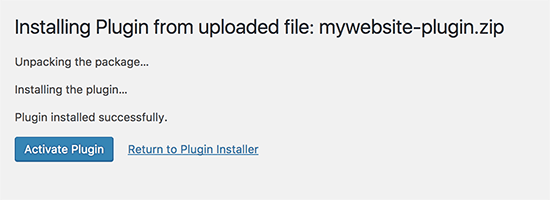
2. Suba el plugin de WordPress específico de su sitio a través de FTP
Para este método, no es necesario crear un archivo zip. Subirá el plugin a través de FTP.
En primer lugar, deberá conectarse a su sitio web mediante un cliente FTP.
Una vez conectado, vaya a la carpeta /wp-content/plugins/ en la columna del sitio remoto. A continuación, debe seleccionar la carpeta de plugins específica de su sitio y subirla a su sitio web.
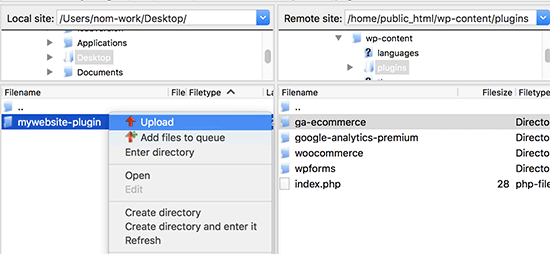
Su cliente FTP transferirá la carpeta de plugins específica de su sitio a su sitio web WordPress. Esto instalará el plugin en su sitio web.
Sin embargo, deberá activar el plugin para empezar a utilizarlo. Para ello, vaya a la página “Plugins” del área de administración de WordPress y haga clic en el enlace “Activar” situado debajo del plugin específico de su sitio.
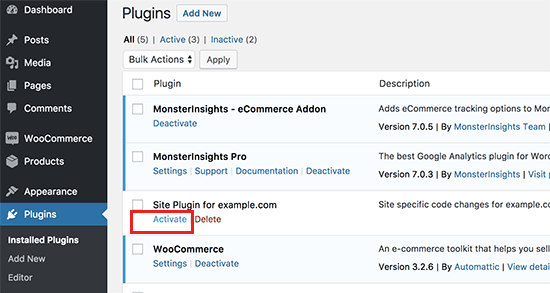
Eso es todo. Su plugin específico del sitio está listo para ser utilizado.
Añadir fragmentos de código personalizados a su plugin específico del sitio
Hay dos formas de editar su plugin y añadirle fragmentos de código personalizados.
El primer método es hacerlo a través del área de administrador de WordPress. Puedes ir a la página Plugins ” Editor.
Verá un mensaje de advertencia y deberá hacer clic en el botón “Entiendo” para continuar. Alternativamente, si desea una forma más segura de editar los archivos, omita el segundo método a continuación.
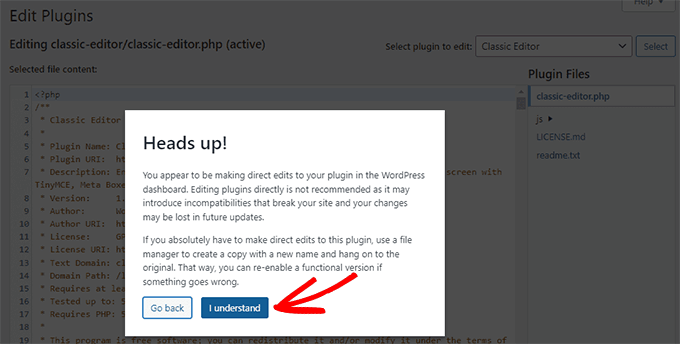
A continuación, seleccione el plugin específico de su sitio en el menú desplegable “Seleccionar plugin para editar”.
El editor cargará tu archivo de plugins y podrás añadirle fragmentos de código.
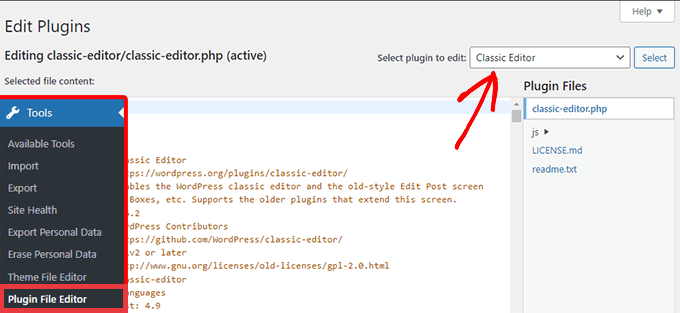
Cuando haya terminado, haga clic en el botón “Actualizar archivo” para guardar los cambios.
Si falta algo en el código o puede romper tu sitio web, el editor de plugins deshará automáticamente los cambios.
Sin embargo, si el editor falla, y ves la pantalla blanca de la muerte, entonces puedes usar FTP para editar el archivo de tu plugin y deshacer esos cambios.
El segundo método consiste en editar directamente el archivo del plugin mediante FTP. Simplemente vaya a la carpeta de plugins utilizando su cliente FTP. Haga clic con el botón derecho del ratón en el archivo del plugin y seleccione “Ver/Editar”.
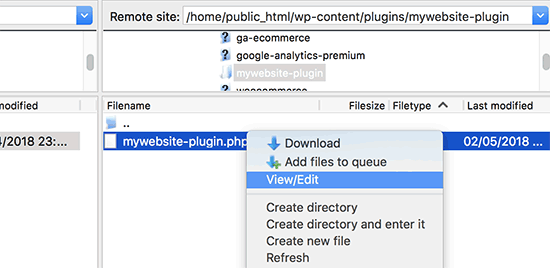
También puede descargar el archivo del plugin a su ordenador, editarlo y volver a subirlo.
Método 2: Añadir código personalizado usando WPCode (Recomendado)
Este método es mucho más sencillo y le ofrece una mejor forma de gestionar sus fragmentos de código individuales en WordPress utilizando WPCode.
Lo primero que tienes que hacer es instalar y activar el plugin gratuito WPCode en tu sitio web. Para más detalles, consulta nuestra guía paso a paso sobre cómo instalar un plugin de WordPress.
Entrada relacionada: Para más información, echa un vistazo a nuestra reseña completa de WPCode.
Una vez activado, el plugin añadirá un nuevo elemento / artículo llamado “Fragmentos de código” a su menú de administrador de WordPress. Al hacer clic en él, accederás a una página en la que podrás gestionar todos tus códigos personalizados.
Para añadir su primer fragmento de código, haga clic en el botón “Añadir nuevo”.
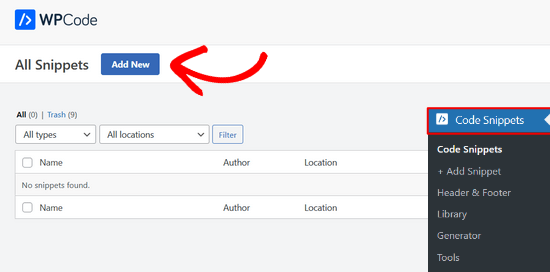
Accederá a la página “Añadir fragmento de código”. Aquí puede elegir un fragmento de código de la biblioteca prediseñada o añadir su código personalizado.
Para añadir código personalizado, vaya a la opción “Añadir su código personalizado (nuevo fragmento)” y haga clic en el botón “Usar fragmento”.
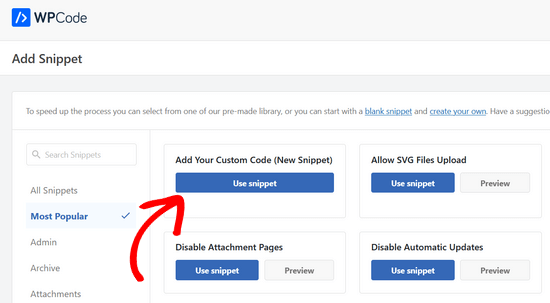
Ahora, puede introducir un título para su fragmento de código personalizado. Puede ser cualquier cosa que le ayude a identificar el código.
Después de eso, puede seguir adelante y pegar su fragmento de código en el cuadro de código. También tienes que seleccionar el tipo ‘PHP Snippet’ de la lista desplegable ‘Tipo de código’ de la derecha.
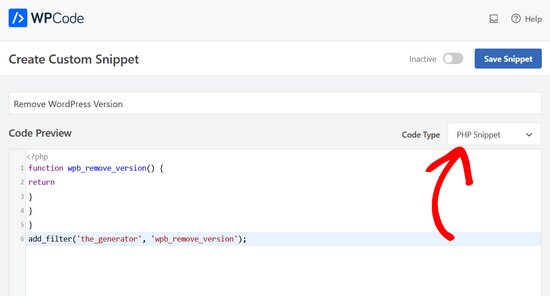
También puede añadir notas para el código en la sección “Información básica”.
En esta zona debe anotar qué hace este código, dónde lo encontró y por qué lo añade a su sitio web. Esto ayudará al “tú del futuro” a recordar por qué el “tú del pasado” añadió este código.
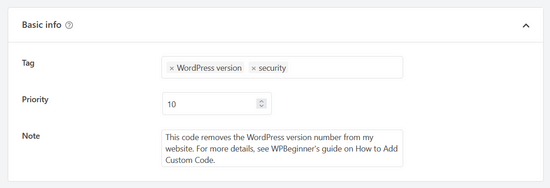
También tiene la opción de asignar etiquetas a sus fragmentos de código, lo que puede ayudarle a organizarlos por debate y funcionalidad.
El plugin también te permite seleccionar cómo quieres ejecutar el fragmento de código. En la sección ‘Inserción’, puedes seleccionar el método ‘Auto Inserción’ para insertar y ejecutar automáticamente el código en tu sitio.
Puede elegir entre las opciones de área de administrador, front-end o en todas partes. Si no está seguro, mantenga la opción por defecto “Ejecutar en todas partes”.

También puede elegir el método ‘Shortcode’. Con este método, el fragmento de código no se inserta automáticamente. Una vez que guarde el fragmento de código, obtendrá un shortcode que podrá insertar manualmente en cualquier parte de su sitio.
También puede utilizar la sección “Lógica condicional inteligente” para mostrar u ocultar fragmentos de código insertados automáticamente en función de una serie de reglas.
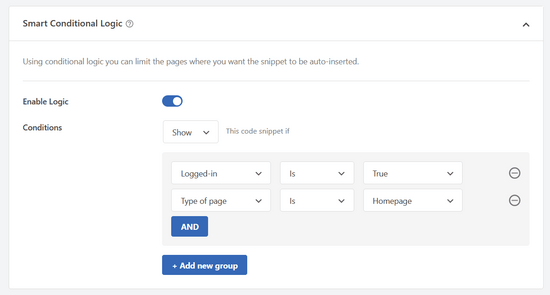
Por ejemplo, puede cargar fragmentos de código solo para usuarios conectados, cargar fragmentos de código PHP solo en URL de páginas específicas, mostrar fragmentos de código en función del tipo de página, etc.
Por último, puede cambiar el conmutador de “Inactivo” a “Activo” y, a continuación, hacer clic en el botón “Guardar fragmento de código”.

Si desea guardar el fragmento de código sin activarlo, solo tiene que hacer clic en el botón “Guardar fragmento”.
Una vez que haya guardado y activado un fragmento de código, éste entrará automáticamente en vigor en su sitio web si ése es el método de inserción que ha elegido.
Para más detalles, consulte nuestra guía sobre cómo añadir fácilmente fragmentos de código personalizados en WordPress.
Esperamos que este artículo te haya ayudado a aprender por qué y cómo crear un plugin de WordPress específico para un sitio. Es posible que también desee ver nuestra lista de consejos útiles archivo de funciones y los hacks de WordPress más buscados para utilizar mejor su plugin específico del sitio.
If you liked this article, then please subscribe to our YouTube Channel for WordPress video tutorials. You can also find us on Twitter and Facebook.




BSubra
Is it possible to add code snippets like Google Analytics Code, Adsense code in Site Specific Pliugin. Or only possible to add codes we generally put in functions.php file.
I mean, is it possible to add codes in site-specific plugin what we generally put in Header.php file.
WPBeginner Support
You can do that if you would like, you can also use the insert headers and footers plugin.
Admin
Bola Oussou
hi
Thanks for this tuto
however is there a way to make this plugging(not to be visible) not in plugging list and also in a specific folder (not wp-content folder) ?
Thanls
Tor-Bjorn Fjellner
Actually yes, there is:
Instead of placing the plugin in …/wp-content/plugins/ you put it in …/wp-content/mu-plugins/ (You may have to create that directory, if it’s not there yet.
Plugins that are placed in mu-plugins are ALWAYS run, so the only way to deactivate a MU plugin (MU currently is construed as “must use”) is to delete it (or remain the directly mu-plugins to something else…).
Judith
Hi I tried to do the Site-specific plugin, but it is not working, I get this message “The package could not be installed. No valid plugins were found.
Plugin installation failed.”
What do I do?
WPBeginner Support
Hi Judith,
This usually means that the plugin header information is incorrect. You can try again and make sure that your plugin header is exactly in the format displayed in the tutorial.
Admin
Jonathan Manheim
I get this same error. I have tried maybe 10 times. Uploaded through admin and on FTP. Cannot get it to upload. I am using TextEditor to paste the code. Notice several things you don’t mention in the post that I wonder could be an issue. First, won’t let me save the file as .php. I have to save it as .php.rtf OR .rtf then go back and rename the file after it is saved.
Second, not sure what you mean by making sure the format for the plugin header is exactly the same. Should the line number be in there? If so, I can’t get that to work. If I copy and paste with the line numbers, the green vertical line doesn’t show up and there is no space between the line numbers and the code. Or am I supposed to just copy the code (without the line numbers)? Either way, I’ve tried everything I can with my current Textedit application and it will not work.
Any ideas? I can send you screen shots of exactly what I have if you would like
WPBeginner Support
Hi Jonathan,
You will need to save file as .php. Please use a different text editor on Windows you can use Notepad or download Notepad++. On Mac, you can use TextEdit or download and install TextWrangler.
You don’t need to copy and paste line numbers.
Kacper
In my case the issue was that the file had Unicode encoding. Changing it to ANSI fixed the issue.
Ikram
Hi,
Good day!
Would like to know how to set a white paper in my blog post article to download it with add email address from the visitor.
Thanks, Ikram
WPBeginner Support
Hi Ikram,
You can do that with the pro version of WPForms. You will need at least Plus plan for that. After users enter their email address and click submit you can redirect them to the download page.
Admin
Alain Fradette
Great info! Thanks so much. I have been using WordPress for years and this little gem made it so much easier!
Abhijeet
I have edited some code in Style.css . Will it be overwritten if i update a theme?
is it possible to create style css file in this site specific plugin?
LFreitas
Yes, they will.
You should create a child theme and put your modifications there instead of in the original theme.
Read more: https://www.wpbeginner.com/glossary/child-theme/
dave
White screen on publishing pages.
The code works to show child pages on a parent page using the shortcode however I am getting white screen. Anyone know why?
Tommy
The plugin generated 3 characters of unexpected output during activation. If you notice “headers already sent” messages, problems with syndication feeds or other issues, try deactivating or removing this plugin.
Saurin
I believe best approach to add custom code to site is child theme. No matter if we need to customize theme or not. I mad a practice to always use child theme even if there is no customization. This habit saved my time & effort many times. I dont think it is good to create extra plugin for such customization.
I believe in minimum use of plugin no matter how simple you created one.
Jason
Which is better, site-specific plugin or Child Theme? or both?
I need to create a custom post type to add some major functionality to my site so is the plugin better or the child theme and its functions.php?
Thanks!
Josh
The thing is, is that you’re creating the plug-in yourself, using the functions the same exact way. So the answer to your question would be that neither is better, because you should be using them WITH each other.
Josh
Think of the site-specific plug-ins as functions that are independent of your theme.
Vickey
How would I create a create a new plugin directory in Azure? I have WordPress running on Azure using MS SQL Server, which I activated using Project NAMI.
vishal
not working on multisite with publisher theme can you help me this is my site and also tell me how can i remove featured image inside the post not from front page latest post
Nadia Khan
Hi there,
You WP Beginners are rock. and I want to thank you for your Struggles for us.
Now come to the point. I have installed an theme and in that theme, there is an function that is showing wp toolbar for guests, I have tried so many times to find this function in theme files to remove this, but i can’t. So please help me to remove that toolbar, that is showing to every visitor with wordpress logo and wordpress’s own link to their website. Screen Shot is attached.
Manuel
Does something like this work for plugins too? Im finding that I am making a few changes to plugins that I add to my site….many times deleting certain lines of code I dont want. I’m assuming that after I update that plugin, all my changes will be erased. How can I avoid this?
Elizabeth
Hi, thanks for the post. I’m getting an error when I activate the plugin for some reason:
Parse error: syntax error, unexpected ‘*’, expecting identifier (T_STRING) on line 9
Any ideas what I’ve done wrong?
Thanks!
WPBeginner Support
Hi Elizabeth,
There is an unexpected asterisk sign in the code on line 9 which is blocking the php script. Edit the file again and copy the code exactly as it is shown above. Make sure that you don’t copy line numbers in the code click on the Copy button at the top right corner of the code snippet box
.
Admin
Steven Denger
I tried naming the new folder as you did in the example but I got an error that said something in the way of you cannot use a name like this. This Instruction may be helpful to some – but it is very difficult and confusing to me and does not help at all. As I said – you need to explain this down to the fine details or otherwise these tutorals will not help. The name of this site is wp BEGINNER – and that is what I am. You project these tutorals to the more experienced.
I guess I will have to start going elswhere to get beginners instructiions because, most of time, wp beginner is not helpful – it is more like a techs only club.
Steven Denger
How do you get to the /wp-content/plugins/yoursitename-plugin/ in wordpress and upload a file there? I am lost on the first line of instruction. You guys always assume that we know these things in your instructions but they are not clear enough.
I went to cpanel and opened up the wpcontent > plugins – and it shows a list of plugins – but I am lost from this point. How do I go about uploading a file in here? I am a beginner – and you guys seem to always explain things like your instructing experienced techs. I am not but I go to WP Beginner to try to learn. It is usually difficult to follow your instructions and I end up having to go somewhere else in google search to find things explained down to a beginners level.
If you want to be more helpful try breaking things down a little more simple.
Manuel
Hey Steven,
I know the feeling! I’m far from a expert with wordpress and I pretty much live on google searches and this site trying to learn. I know a little bit and was able to get this to work. Send me your email and I’ll send you the steps with screenshots. I havent tested putting actual code into the plugin so we’ll see if that works….but I was able to see the newly created plugin on my admin page
Steven Denger
thank you manuel
NiceRazer
Hello, can you please tell me how to do that to? I’ve tried finding posts that would help me with this same prob but still didnt found it.
JoAnn Chateau
Thank you for the great advice and simple how-to instructions. I easily created a Site-Specific WordPress Plugin for my site and enabled shortcodes for widgets. Now I have less worry when changing themes, and I didn’t need to install another plugin. Again, thanks!
george
hi i followed the instruction on how to make a site plugin for my site. ive uploaded it but cant see it in my list of plugins.
any ideas why?
Dawn
I cannot find where the folders live in the plug in directory. I tried searching for: /wp-content/plugins/yoursitename-plugin/ (with my site name).
Kara
Never mind, I figured it out and got it activated. My hosting server was acting up, must have timed out or something…cheers!
Kara
I followed your instructions but i don’t know how to activate it. It doesn’t show in my list of plugind in my wp-admin. Can you help?
Sheyejinkazama
Thank you. Thank you so so much.
Molly
How do you get the plugin to “Network Activate” on a multi-site?